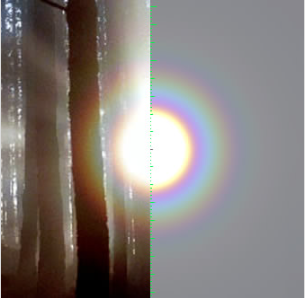Forest corona and simulator test
Forest Corona and Simulator Test: Unveiling the Spectacle of Atmospheric Optics
Atmospheric optics never fails to amaze us with its captivating displays of light and color. One such phenomenon is the forest corona, a mesmerizing sight that can be witnessed under specific atmospheric conditions. Let's dive into the world of forest coronas and explore a simulator test that sheds light on the science behind this captivating spectacle.
Exploring the Forest Corona
The forest corona is a beautiful optical phenomenon that occurs when sunlight interacts with water droplets suspended in the air. When sunlight passes through these tiny droplets, it undergoes diffraction, resulting in the formation of colorful rings. The forest corona is unique because it appears to encircle the silhouette of nearby trees, adding an enchanting touch to the spectacle.
A Captivating Capture
In May 2000, Till Credner and Sven Kohle, avid enthusiasts of atmospheric optics, captured a stunning forest corona on the picturesque island of Tenerife. Their photograph showcased fragments of three to four rings shining above the aureole, accompanied by the mesmerizing presence of crepuscular rays radiating in all directions. This image exemplifies the ethereal beauty of the forest corona phenomenon.
The IRIS Simulator Test
To unravel the secrets behind the forest corona, scientists turned to the IRIS Mie scattering simulator for answers. In a serendipitous turn of events, a glory, another optical phenomenon created by similar-sized droplets, was observed in the opposite direction. This provided a unique opportunity to test the accuracy of the simulator.
The Power of Comparison
By comparing the forest corona and glory sightings, scientists could determine if the same-sized droplets were responsible for both phenomena. The angular scale of the images was meticulously gauged from the camera lens focal length, enabling precise analysis. Interestingly, it was found that 13.5-micron diameter droplets were the best fit for both the forest corona and the glory. This discovery further solidified the connection between these two captivating optical phenomena.
The Importance of Ring Fitting
When analyzing the forest corona image, scientists focused on fitting the rings rather than the aureole. This decision was made due to the variability of the aureole's size in images and simulations, which heavily depends on exposure and brightness settings. By concentrating on the rings, a more accurate representation of the droplet sizes could be achieved. Surprisingly, it was discovered that monodisperse droplets (droplets of uniform size) provided the best match to the image, eliminating the need for a spread of droplet sizes.
Unveiling the Glory
The glory image captured simultaneously with the forest corona also confirmed the presence of 13.5-micron diameter droplets. This remarkable consistency in droplet size further supports the hypothesis that these droplets are responsible for both phenomena. The glory, characterized by its concentric rings of color, added another layer of enchantment to the atmospheric optics display.
The Beauty of Atmospheric Optics
The forest corona and the glory are just two examples of the captivating wonders that atmospheric optics has to offer. These phenomena serve as a reminder of the intricate interplay between sunlight and water droplets in our atmosphere. Through scientific analysis and simulator tests, we can gain a deeper understanding of these optical marvels, uncovering the secrets behind their mesmerizing displays.
Conclusion
The forest corona and simulator test provide a fascinating glimpse into the world of atmospheric optics. Through careful analysis and comparison, scientists have unraveled the connection between the forest corona and the glory, shedding light on the droplet sizes responsible for these captivating phenomena. As we continue to explore and understand atmospheric optics, we are reminded of the beauty and complexity of the natural world that surrounds us. So, the next time you find yourself in a forest, keep an eye out for the enchanting spectacle of a forest corona, and marvel at the wonders of the atmosphere.

Forest corona captured by Till Credner and Sven Kohle (atmospheric optics site) on the island of Tenerife in May 2000.
Fragments of three to four rings are visible above the aureole and to add to the spectacle, crepuscular rays fan in all directions.
The corona forming droplets are close because the rings shine in front of the nearby trees.
Photo ©Till Credner & Sven Kohle and reproduced with permission

IRIS simulator test
In the opposite direction there was a glory. The droplets creating both were likely of the same size and thus the two sightings provide a test of the IRIS Mie scattering simulator.
In the split image the angular scale (major ticks 1°) were gauged from the camera lens focal length.
The IRIS corona best fitting the image was from 13.5 micron diameter droplets. The rings rather than the aureole were used for fitting because the aureole's size in images and simulations depends too much on exposure and brightness settings. No spread of droplet sizes was needed, monodisperse droplets best matched the image.
Did the same sized droplets fit the glory seen at the same time? Yes they did, check the glory image.
Note: this article has been automatically converted from the old site and may not appear as intended. You can find the original article here.
Reference Atmospheric Optics
If you use any of the definitions, information, or data presented on Atmospheric Optics, please copy the link or reference below to properly credit us as the reference source. Thank you!
-
<a href="https://atoptics.co.uk/blog/forest-corona-and-simulator-test/">Forest corona and simulator test</a>
-
"Forest corona and simulator test". Atmospheric Optics. Accessed on November 26, 2024. https://atoptics.co.uk/blog/forest-corona-and-simulator-test/.
-
"Forest corona and simulator test". Atmospheric Optics, https://atoptics.co.uk/blog/forest-corona-and-simulator-test/. Accessed 26 November, 2024
-
Forest corona and simulator test. Atmospheric Optics. Retrieved from https://atoptics.co.uk/blog/forest-corona-and-simulator-test/.